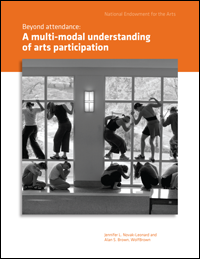Beyond Attendance: A Multi-Modal Understanding of Arts Participation
2011, 104 pages, National Endowment for the Arts, 1100 Pennsylvania Avenue NW, Washington, DC, 20506, http://www.nea.gov
Download:
![]() Beyond Attendance: A Multi-Modal Understanding of Arts Participation (5.4Mb)
Beyond Attendance: A Multi-Modal Understanding of Arts Participation (5.4Mb)
First conducted in 1982, the NEA’s Survey of Public Participation in the Arts (SPPA) serves as the longest-standing resource for studying U.S. adult levels of arts attendance, personal arts creation and performance, and arts participation through electronic media. The SPPA evolved from the need to establish a consistent baseline for quantifying arts audiences nationwide. It also evolved from the need to collect better information about those audiences, in keeping with the NEA’s programmatic and policy priorities at the time of the survey’s development. Today, SPPA-based information about arts attendance continues to provide the nonprofit arts sector with useful, reliable information about Americans’ rates of participation in live arts events.
The environment in which arts organizations function has changed dramatically in the 29 years since the first SPPA. Alternatives for arts and entertainment activities have proliferated, and expectations for personalization and individual control over those experiences have increased. The proliferation of new technologies for interacting with digital content is occurring at a heightened pace, while the nation’s demographic characteristics grow increasingly diverse.
For arts funders and grantee organizations alike, conferences and meetings have tended to focus on adapting to this new environment. Such discussions often lead to debates over what “arts participation” is and how arts organizations might best channel the myriad pathways through which Americans now engage in artistic and creative expression. Those pathways are blurring in several important respects. The evolution of art forms themselves is inevitable and this evolution is rapidly underway with the introductions of new or blended forms that infuse technology, different cultural traditions, and elements of multiple art disciplines. Similarly, the settings in which Americans choose to engage in arts activities have long expanded well beyond purpose-built arts facilities, moving into bookstores, community centers, schools, places of worship, and especially the home. The nonprofit arts and cultural sector has grown accustomed to these shifting boundaries of participation — a realization that takes in a larger swatch of the “cultural ecology,” including professional arts, personal participatory practice, and cultural literacy.
Using SPPA data from 1982–2008, this monograph explores the breadth of participation within and between three primary categories, or “modes,” of arts activities: arts attendance, personal arts creation and performance, and arts participation through electronic media. In addition, the monograph offers a unique context for understanding arts participation, suggesting that a more expansive framework for the cultural ecology is needed, and discusses implications of the SPPA data and other trends for practice, policy, and future research.

